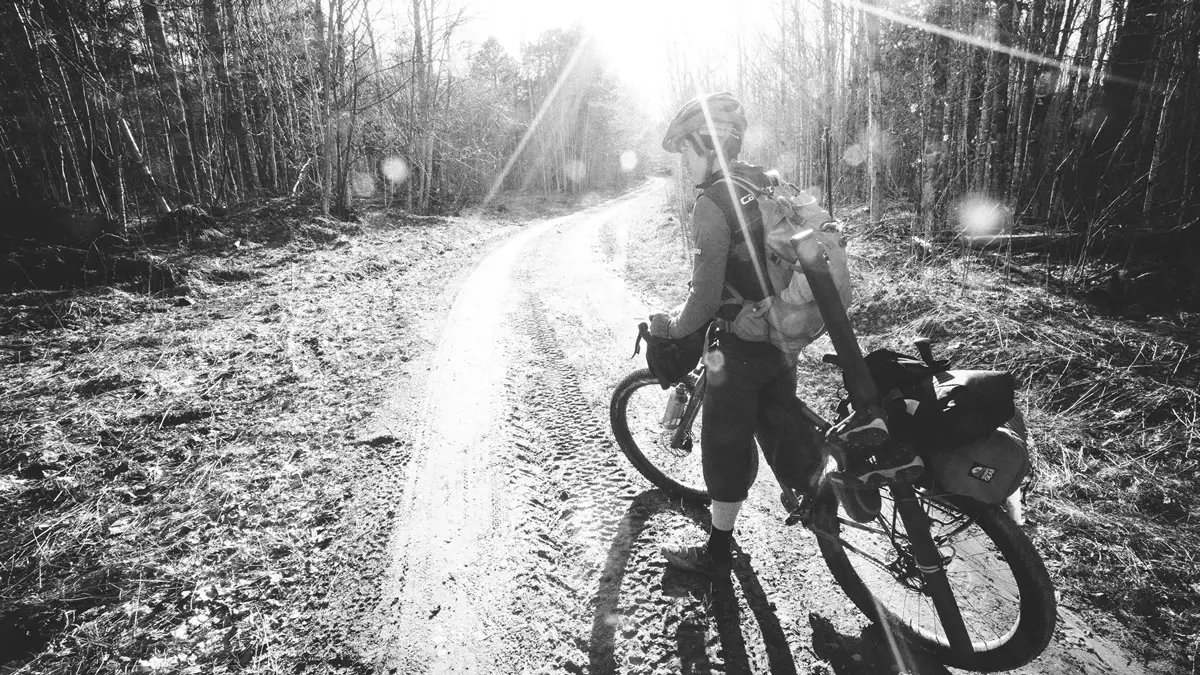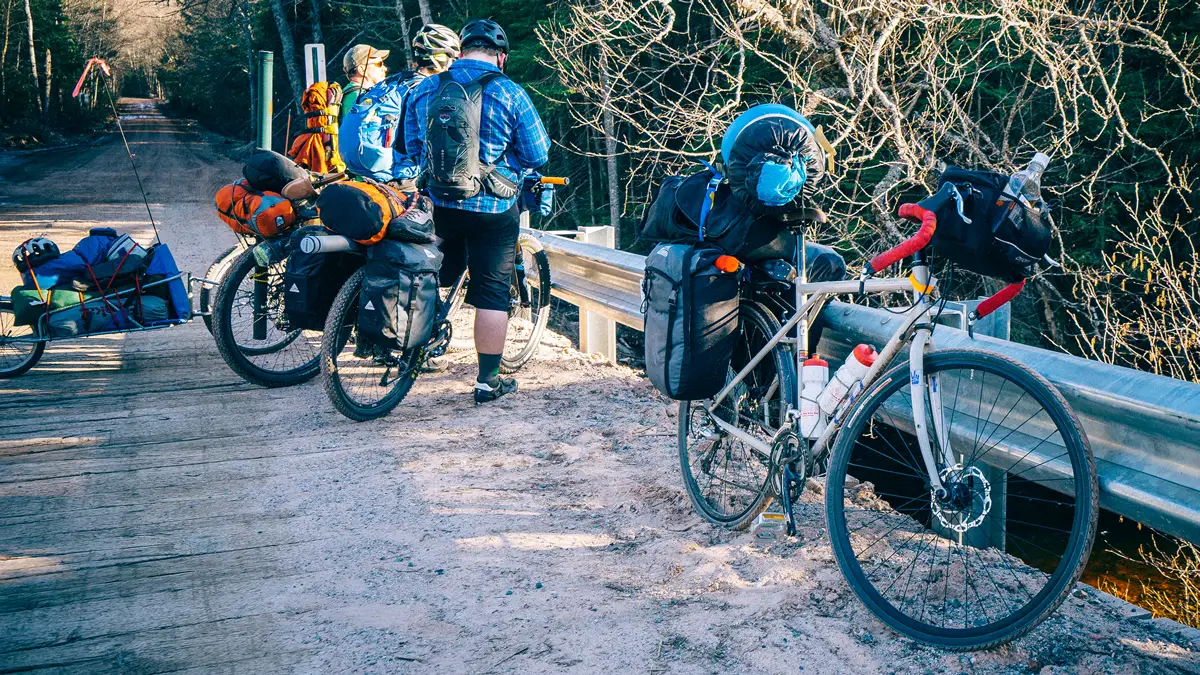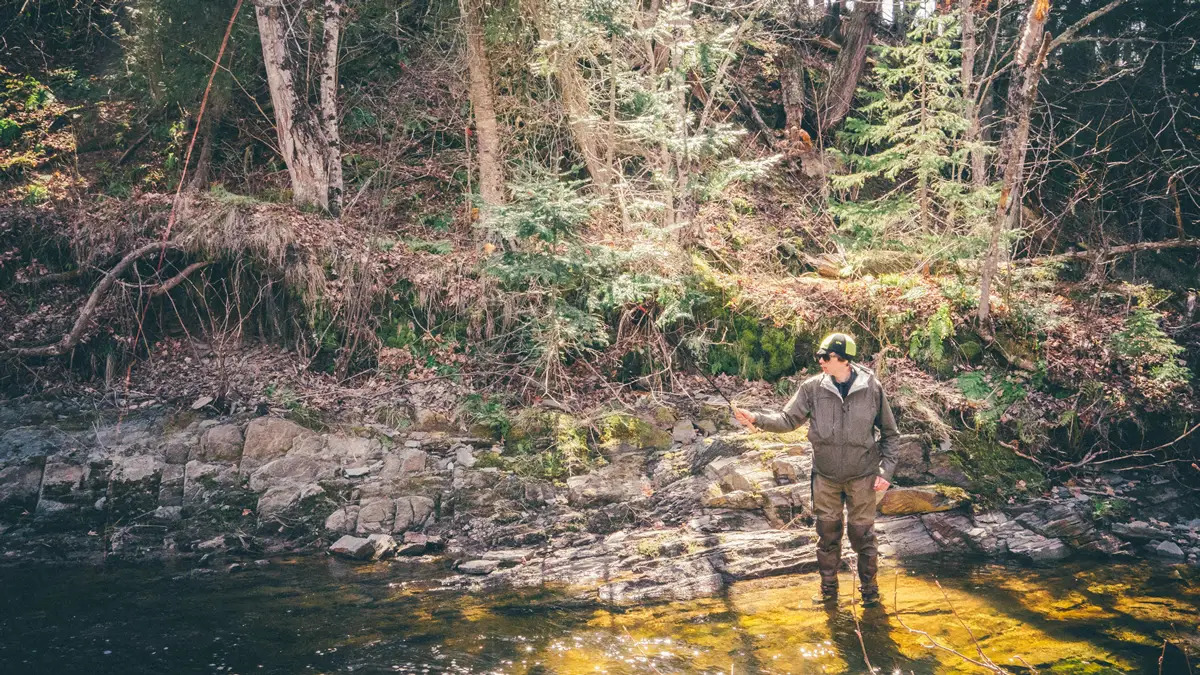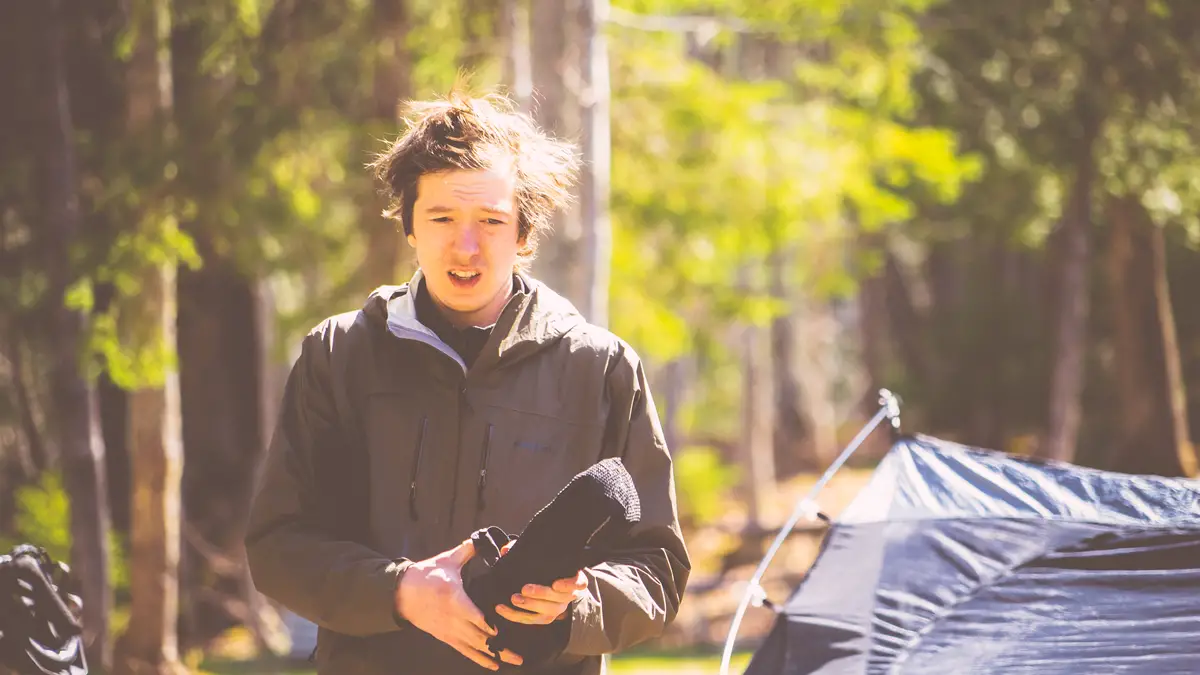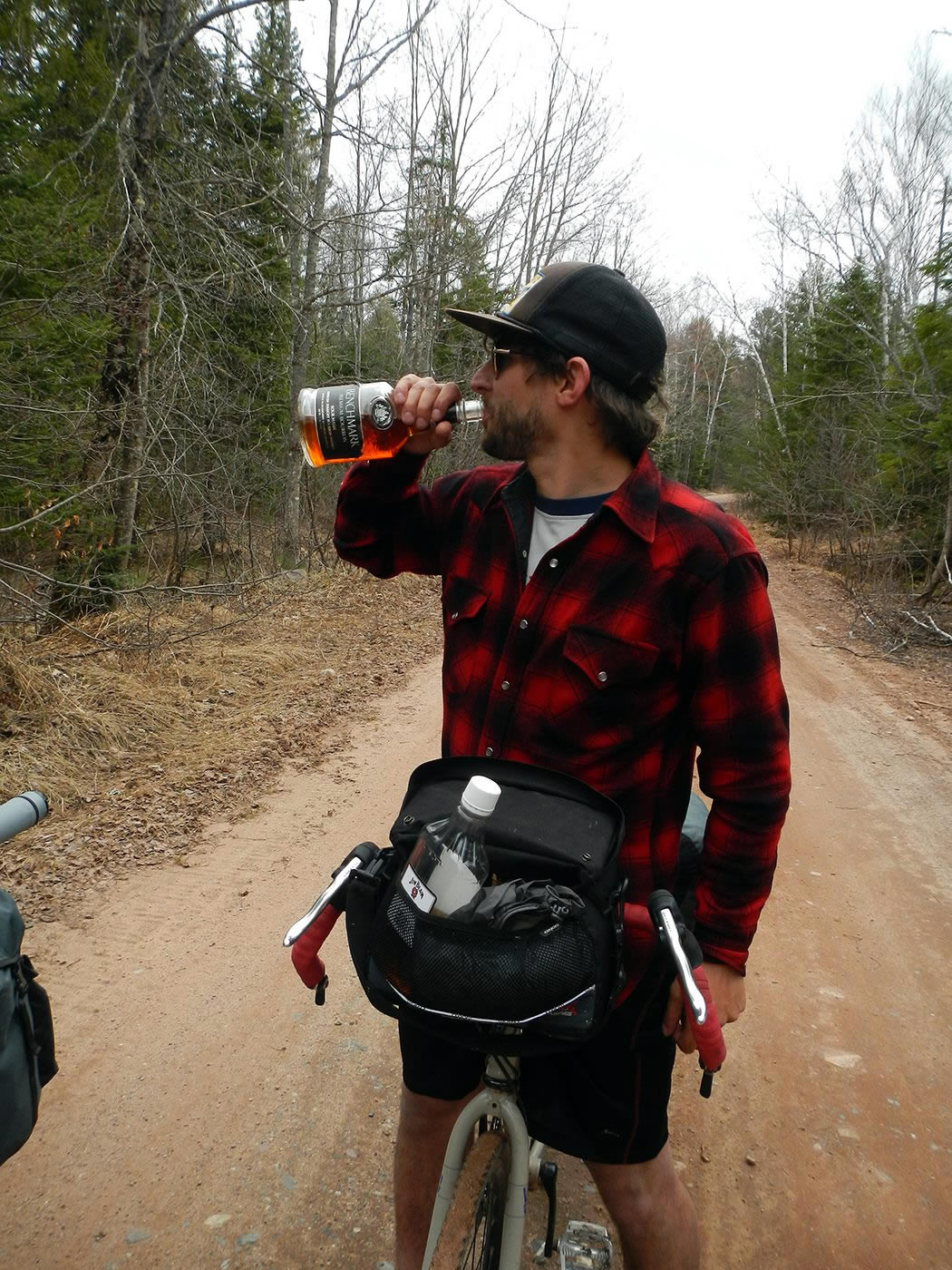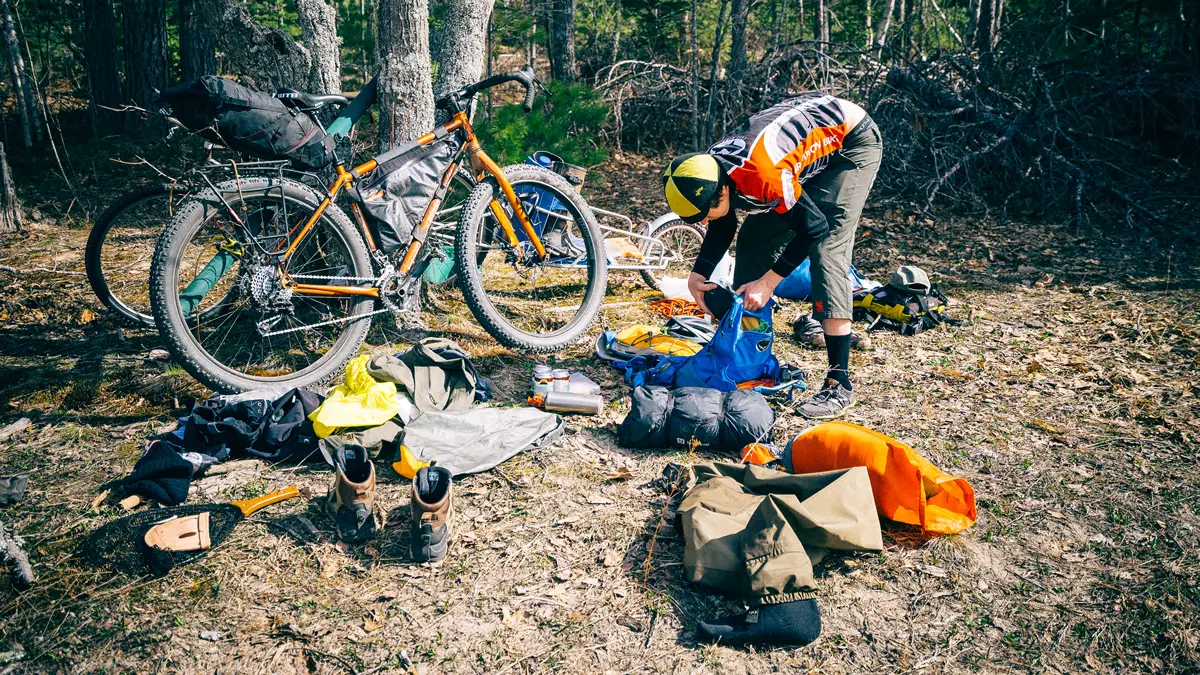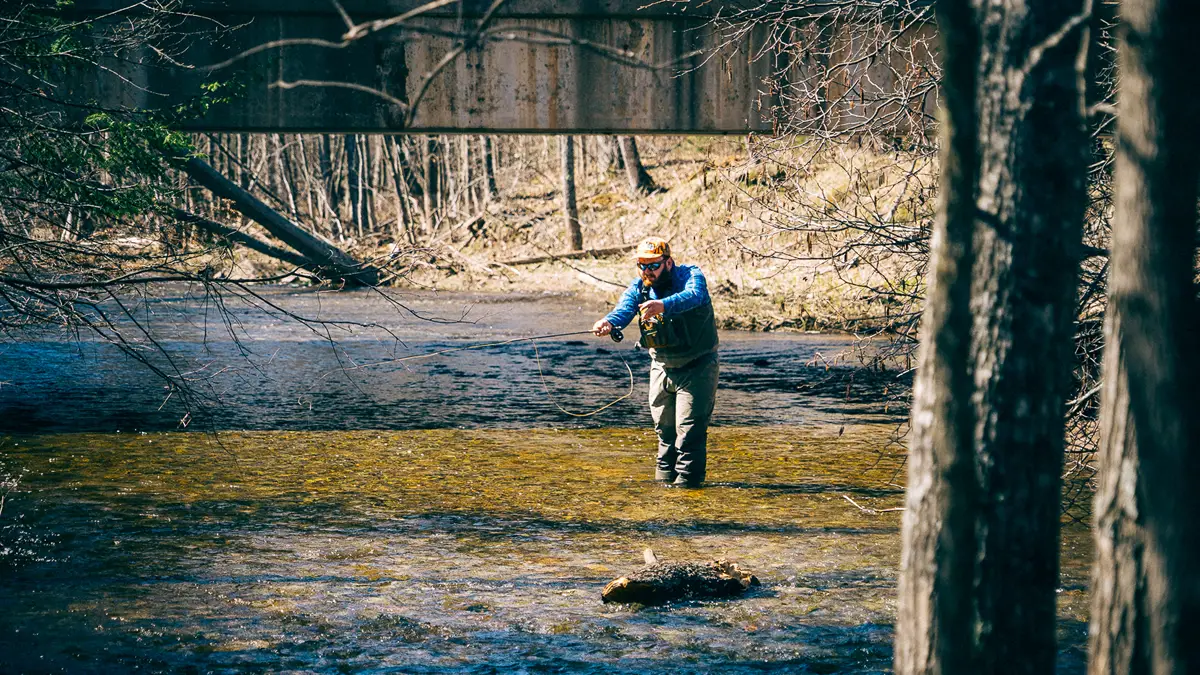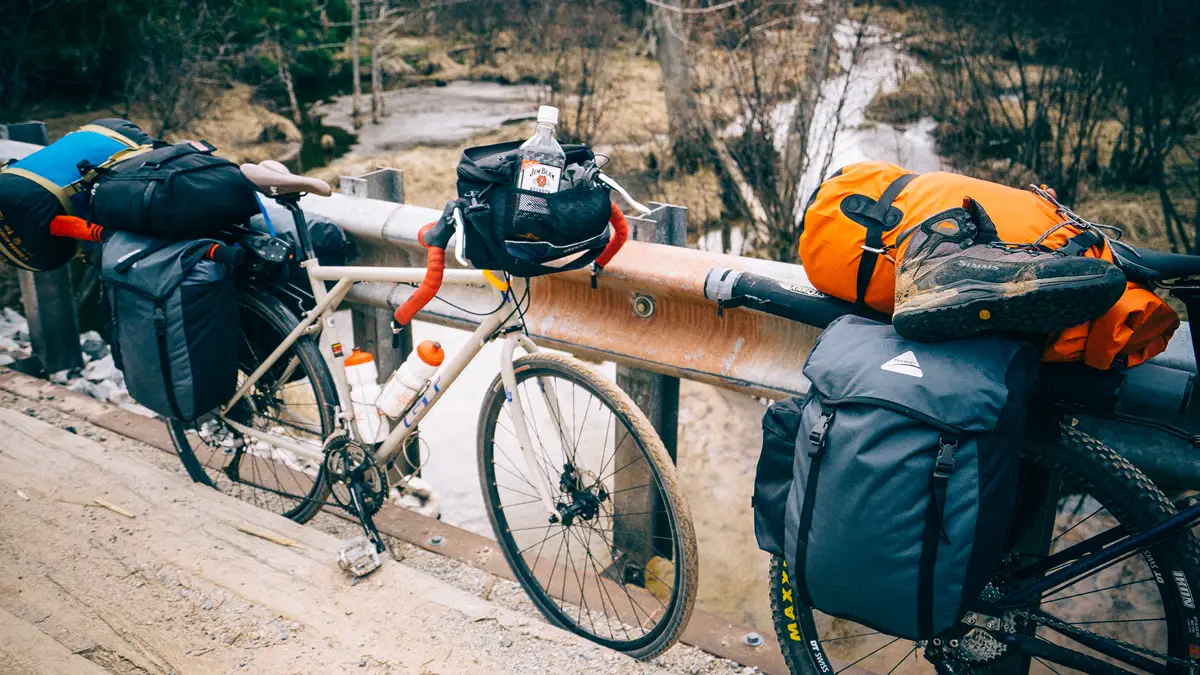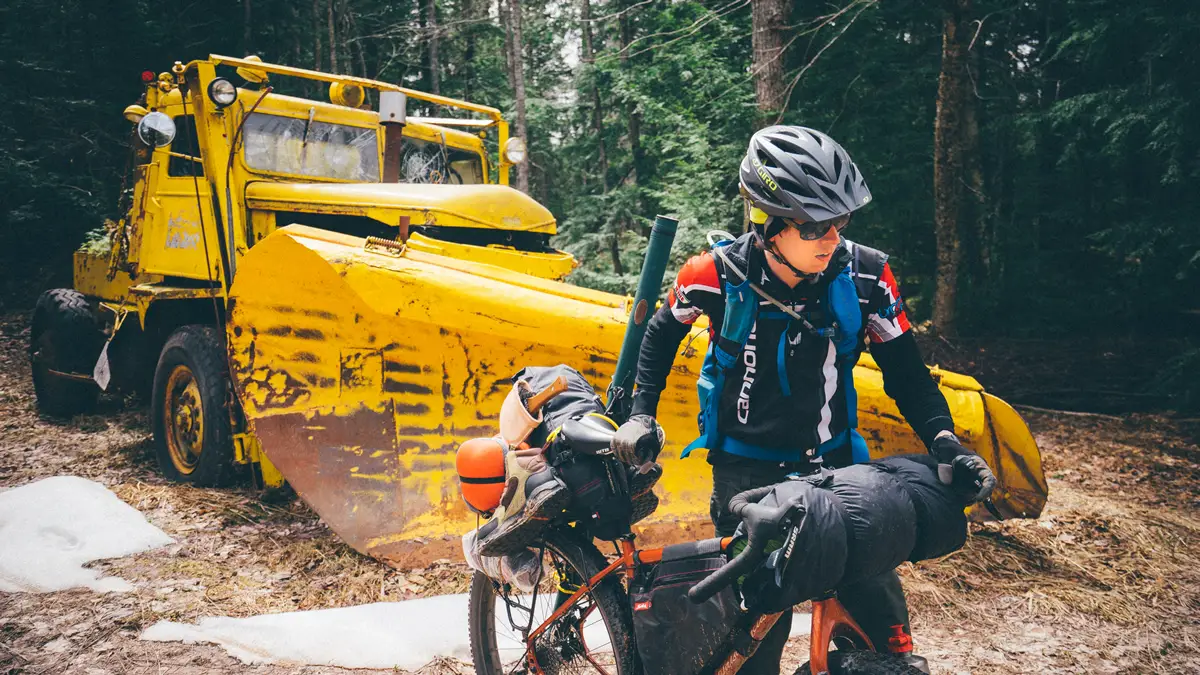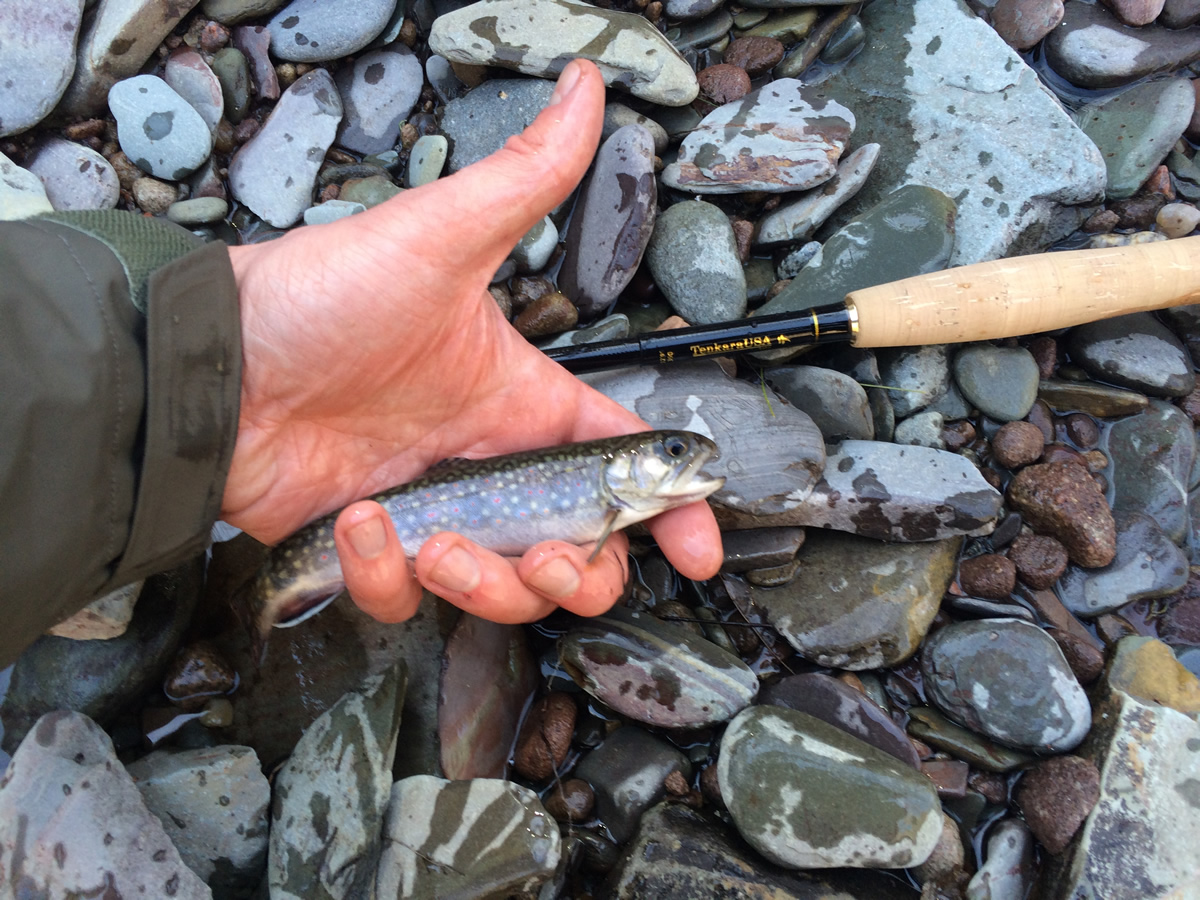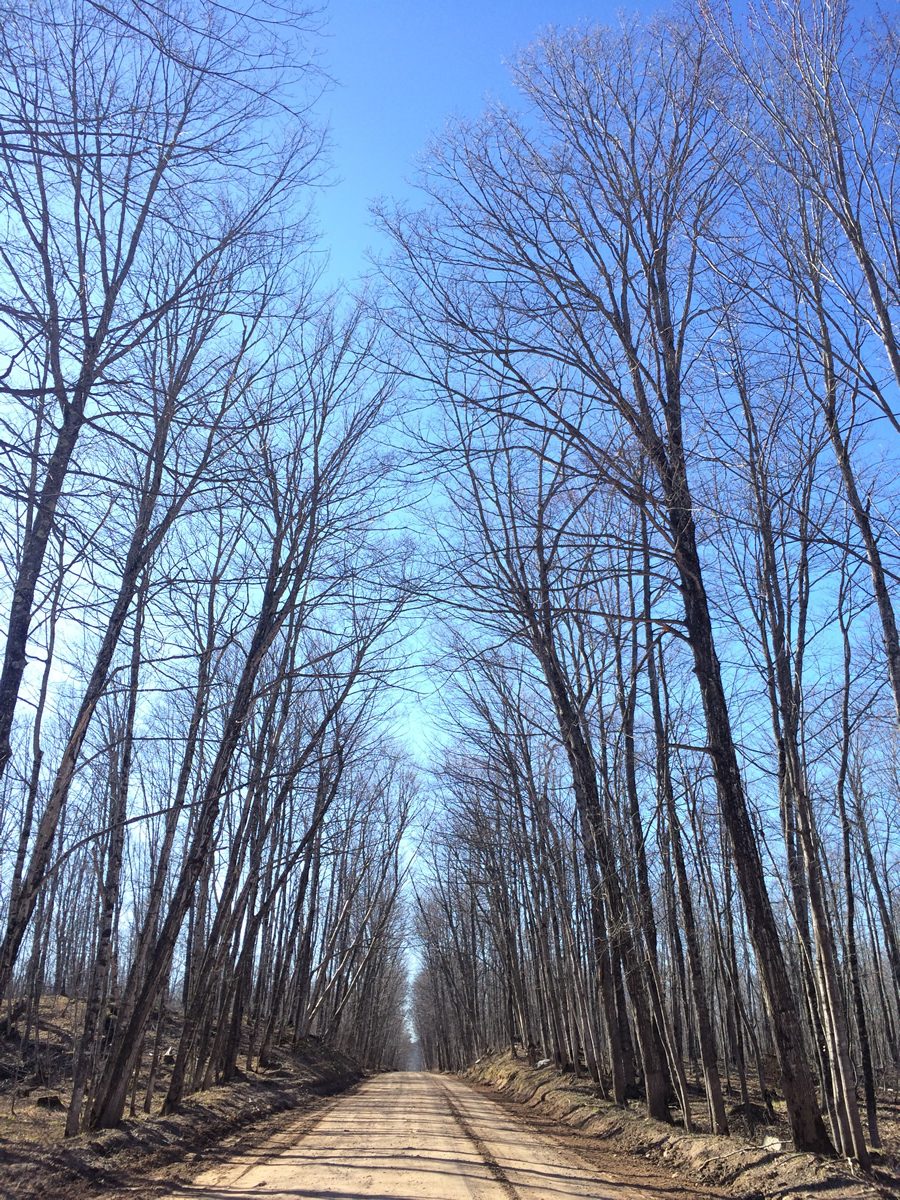Seeking fish, adventure and friendship on two wheels.
WORDS BY RYAN LABAR
PHOTOS BY GAVIN GIBSON, RYAN LABAR & BOB HENDRICKSON
We straddled our bikes in silence atop a bridge, staring down into the dark depths of a deep bend on the Yellow Dog River. The water was clear, but stained with gracefully swirling amber hues. A bottle of Beam was pulled from Gavin’s handlebar bag and passed around. Our legs were tired, and our hands numbed by the miles of gravel behind us.
The silence was broken by Bob: “Oh man, I just want to drift a worm through there,” speaking of the river’s bend, not the whiskey. We were all thinking it. And all of us had our fishing poles at the ready, but we couldn’t wet our lines. It was the eve of the Trout Season Opener, and even if we didn’t get caught, even if nobody else knew, we weren’t about to tread on the sacred.
Trout Season Opener in Michigan’s Upper Peninsula is an unofficial holiday with an almost religious importance. It’s only superseded by Deer Season where many businesses will shut down for a week, and most make work optional. Lucky for the local economy, Trout Season lasts for five months, and not two weeks as with deer season. Andrew, Bob, Gavin, and I had all taken at least half a day off work for this pilgrimage.
We designed the route to push us through some of the most remote land, as well as some of the most renowned trout streams, in the state. Our planned path was set to guide us from Negaunee to Skanee, covering far over 100 kilometers of remote gravel and dirt roads.
The only real knowledge of the route we had was given to us as a whimsical recap of a similarly routed ride by a local bike shop employee who helped plot our path by clicking, dragging, and zooming eccentrically through Google’s GPS view of the area. He told us that cell phones would not get service in this area. Our ‘official’ route map ended up as a conglomerate of hastily scribbled notes and printouts of whichever intersections/landmarks that I managed to find and screenshot on Google.
The Beam made another pass around and we rolled away from the bridge, turning downstream to seek out a campsite for the night. Just as the side road was proving too sandy to continue down with loaded bikes, we happened across a surprisingly flat clearing amongst the trees adjacent to a small pond. It was the perfect spot to set up our tents. We got a fire going, cooked up the bratwursts that thawed over the course of the day, drank a few beers, and passed around a small bottle of Jägermeister that seemed to appear from nowhere.
“They found the missing person’s body this morning,” said Bob over the cacophony of spring peepers singing from the pond. The alcohol eased the sobering reality that just a couple weeks earlier a pickup truck with a blown transmission had been found on our projected route and the owner was missing. The news of the truck owner’s demise brought the remoteness of our trip, and unforgiving nature of springtime in the Upper Peninsula, into focus.
The next morning our heads were foggy but as we sipped coffee and gathered our fishing gear, clarity came through the hope of catching trout. A short hike found us at a series of waterfalls emptying into deep pools that promised to hold sizable brookies. We spent an hour throwing flies and worms into the water without luck before two old-timer locals plodded by us and positioned themselves just up from where we were fishing, doing their best to mimic a cigar-smoking Sphinx Gate. We weren’t seeking a Southern Oracle, so we headed back to the campsite to pack up for the long day in the saddle.
The day’s ride started out rolling steadily through a tunnel-like corridor of leafless hardwoods stretching toward the sky. After an hour of gravel, we skimmed over the only bit of pavement for the day, and turned onto our route’s primary vein: Northwestern Road. Almost immediately, smooth gravel gave way to a naturally stone-cobbled road just wide enough for two pickups to scrape past each other.
After a few hours of spinning, Andrew had stopped to adjust his gear and I got a bit ahead of the group. I spun slowly to let them catch up but after a while I started to worry that someone had a technical issue, so I doubled back. Rounding a curve, I found the three to be mechanical free. However, there was a distinctly different look about them, like I’d missed out on something. I didn’t recall passing any streams that looked like they could have held fish.
“Check it out,” exclaimed Bob, nodding toward the back of his bike, where crammed amongst his other gear was a gleaming half-empty glass jug of whiskey. “We found it just sitting in the ditch back there,” added Andrew, equally excited. “About that…,” replied Gavin, “I’m having second thoughts about keeping it. Something’s off about it. I’m feeling pretty weird.” It became apparent that Gavin had guinea pigged the swill. Bob pulled the jug back out. “Are you sure?” Gavin nodded. After a wine-connoisseur-style swish and spit, Bob agreed, “That does taste extra boozy.” We ceremoniously placed the sketchy ditch whisky back where it had been discovered and continued to ride.
We rolled past the long, one-story building in the ‘populated place’ of Dodge City known by locals as the ‘Rack Shack’. Rumor has it that during deer season the Rack Shack lives up to its double entendre name, and it has nothing to do antlers. Reaching the Rack Shack felt like an accomplishment as it was one of few landmarks scribbled into my notes.
Not far out of Dodge City, our cobbled path abruptly transformed into a rugged Jeep/ORV trail. We hit the Huron Mountains—a punchy little glacier-hewn range that pushes a few hundred meters above Lake Superior (our sea level equivalent). This range makes up for its lack of big elevation with repetition and ruggedness. Reaching these mountains meant that we’d somehow missed the Salmon Trout River, which we had ambitions to fish. With the terrain suddenly much more adventurous and the fact that our overall pace was turning out to be slower than anticipated, we decided not to turn around for it. The deeper into the Hurons we got, the more beautiful the terrain became. The pre-bud, leafless hardwoods offered otherwise invisible views of the largest freshwater lake in the world, which was over ten kilometers away.
After countless leg-burning peaks, a few hike-a-bikes, and increasingly hairy descents, we made it through the Hurons, reaching Cedar Creek. We posted up here for some sandwiches and fishing.
The water looked prime to hold fish, but was incredibly clear and I’m sure if there were fish in the water they saw us long before we saw them. We were skunked for the second time.
The road conditions improved greatly where Ford Road met up with Northwestern and we soon found the second landmark in my notes: a vast field of uniform Christmas-tree evergreens. This marked our turn to follow the Cliff River to Forty-Foot Falls, where we were planning to fish and rest before pushing northwards on roads that even Google didn’t know, toward the mouth of the Big Huron River, our camping destination for the night.
The two-track turnoff descended down into a valley. We didn’t make it far when we encountered a mud pit spanning the entire width of the road and about 20 meters in length. We rode, pushed, pulled, slipped, and dragged our bikes and gear through slimy bottom-bracket-deep grooves left behind by ORV tyres. Despite the relatively short distance, making it though this sludge proved to be a struggle with loaded bikes. Not a kilometer later, we came across another, nastier, mud pit. There were no tyre grooves, just small depressions where the thick wet mud had collapsed in on itself. There was no end in sight either.
We voted and decided it was best we turn back. Our new plan was to take the main road to where our original route would hook back in, and backtrack our way to the mouth of the Big Huron. This route change meant that we would miss most of the streams planned for the day.
Northwestern turned into Erick’s Road, and it was smooth rolling toward Big Eric’s Bridge, which crosses over the Big Huron River. We found the two-track that we were supposed to come in on not far before the bridge, and started toward the mouth of the river. The soft, snowmelt-soaked earth made the going slow. My notes and maps weren’t designed for backtracking. A few dead ends, hunger, exhausted legs, and an increasing doubt that we’d make it to the river’s mouth before sunset caused tensions to build between us. Finally, we uniformly accepted that if we continued we wouldn’t make it anywhere near the river’s mouth before dark.
We sulked back toward the bridge to look for a dry, level spot to pitch our tents. It turned out that Big Eric’s Bridge, much to our relief, was right next to Big Eric’s Bridge State Campground. Thankfully, despite the occasion, there was still a site or two open. We got a fire going, set up camp, cooked a couple of packs of dried creamy broccoli and noodles, and humbly started exhausting the rest of our booze. At some point between bottle passes, Bob busted out a book. It was Trout Madness by Robert Traver (who most famously wrote: Anatomy of a Murder). He opened it, and started reading Traver’s logs of his own Season Opener days in the Upper Peninsula—his success rate brought us comfort, and his quips had us in stitches.
We spent the next morning fishing the Big Huron; however, it quickly became evident that the river had a lot of fishing pressure from the previous day, and the fish, if any were in the area, weren’t going to be enticed. So we packed up our gear and rolled toward our destination. Our greatly shortened ride for the day was a paved, mostly downhill ride to the town of Skanee.
Along the way, we fished the Silver River for a couple of hours, where at least we managed see a fish here, albeit a sucker lying stiff and dead on the bottom of the river.
Our transportation back home was planned to meet us up at 4:00 p.m. at Finn’s, a very local bar and grill. With less than two hours before our trip drew to a close we rolled down to the Slate River, which runs right next to Finn’s.
The group split up early as the Slate is a narrow, rock-shelved stream that doesn’t lend itself to close fishing quarters. I worked my way upstream dancing a fly across every inch of the river that looked like it could hold fish. I checked the time: 3:30. I decided to head up to a small bit of rapids to throw the fly a few more times before trudging back. On my second cast I felt a small tug, but missed, I swung the fly through the knee-deep rapids a few more times without luck. I thought maybe the tug was little more than my hook catching on a rock.
Two casts later, another tug, I set the hook lightly, and the tug started pulling back. I stepped over to the rocky shore, and pulled the fish out of the water. It was a small brook trout, no more than 15 centimeters long. I took a quick photo, gently placed the fish back in the stream and watched it gracefully swim away.
Even if I hadn’t caught an eleventh-and-a-half hour fish, the ride in itself would have been a success. Robert Traver perhaps put it best, in sole reference to fishing, of course, but I’m positive it translates similarly to riding remote dirt and gravel: “I fish because I love to. Because I love the environs where trout are found, which are invariably beautiful, and hate the environs where crowds of people are found, which are invariably ugly.” Amen.

